Mycotoxins: An invisible dark side of climate change

Climate change is expected to have a severe impact on the development of mycotoxins in crops, with negative consequences for livestock health and performance. Farmers need new tools to overcome the challenges in animal feed.
Climate change poses a huge threat to agriculture around the world. Rising temperatures, extreme weather and abnormal variations in rainfall are bad news for crops and livestock. Under these conditions, toxigenic fungi have excellent opportunities for growth. Along with them come mycotoxins, which rank among the most dangerous contaminants in animal feed. If left untreated, mycotoxins can have serious consequences for reproduction and other aspects of livestock performance.
Mycotoxins are secondary metabolites of pathogenic plant fungi. Hard to detect and often undiscovered, they frequently develop in agricultural commodities and pose a hazard to human and animal health. A range of environmental factors create the optimal conditions for growth, before or after harvest and during storage.
Factors beyond control
Our inability to control the most important environmental factor – the weather – is the reason why mycotoxins accumulate most frequently pre-harvest. Interactions between fungi, the host plant and the weather determine the extent of the mycotoxin contamination. The local climate also plays an important role by affecting plant growth and phenology, such as flowering time. Indirect influences on mycotoxin development include the presence or absence of insects and pests and plant stress due to droughts.
As climate change progresses, mycotoxins are expected to become increasingly prevalent in agricultural commodities. Increasingly variable weather may create favourable conditions for mycotoxin build-up during critical windows of plant growth. For example, droughts can increase the risk of aflatoxins (AFLA) and rains after flowering can lead to higher production of deoxynivalenol (DON). All over the world, rising temperatures are likely to alter the risk map regarding the prevalence of specific fungi and the mycotoxins they produce.
MYCOTOXINS AND THEIR ORGINS
More than 700 secondary metabolites of fungi have been described and classified. The best known are: aflatoxins (AFLA), produced by Aspergillus fungi; ochratoxins (OTA), produced by species of Aspergillus and Penicillium; and deoxynivalenol (DON), T-2 toxin, fumonisins (FUM) and zearalenone (ZEN), produced by various species of Fusarium. Depending on the environmental conditions, single fungal isolates can produce a variety of mycotoxins before or after harvest and during storage.
The complexity of prediction
The true nature of climate change is full of unknowns. However, even if we had a clear idea about what lies ahead, predicting changes in mycotoxin occurrence would be far from straightforward. This is because the interactions between pathogens, host plants and weather are complex.
A variety of mycotoxin-producing fungi infect different plants. Among these fungal species, a little-known competitive interaction takes place. Today, researchers around the world are working hard to understand this interaction. Their ambition is to establish models for predicting changes in mycotoxin occurrence due to a warmer temperature, shorter crop cultivation period, earlier flowering and a rising level of atmospheric CO2, for example. Such models could play a key role in preparing feed solutions that protect animal health as well as performance.
Data gathered over the past decade gives an indication of potential trends in mycotoxin occurrence within Europe (Figure 1). In wheat crops, data from 2013 to 2021 shows a trend towards increasing fumonisin levels in Southern, Northern and Central Europe. A similar trend has been identified for aflatoxins in Central and Northern Europe. On the other hand, aflatoxin prevalence in Southern Europe has declined during this time-frame.
Figure 1 – Prevalence of aflatoxins and fumonisins in wheat across Europe 2013-2021.

Serious impact on animal health
Mycotoxin contamination of feed is a cause of significant health problems in poultry, pigs and ruminants. Even when feed only contains low concentrations, mycotoxins build up over time and may damage various organs and systems. Their impact on immunity and gut health often leaves livestock more vulnerable to infection and pathogenic bacteria. Loss of appetite, declining reproductive and growth performance and other signs of compromised well-being are classic symptoms of mycotoxicosis.
In contrast to poultry and swine, it has been thought that the rumen microorganisms of ruminants act as natural detoxifiers. However, while ruminants can cope with a certain level of mycotoxins, there is strong evidence of a negative impact on health, even at mycotoxin concentrations below the detection limit.
Across animal species, the tendency towards increased utilisation of genetic potential to optimise production leaves limited space for animals themselves to cope with external challenges like mycotoxins.
Strategies for prevention
Many farmers are already acting on the problem by using commercially available mycotoxin binders or deactivators in animal feed. In many ways, these are proving to be an effective strategy for preventing and treating mycotoxicosis.
As climate change continues to increase the risk of mycotoxin occurrence, farmers will need more complex tools of this kind in the future. New knowledge about mycotoxins and how they interact with feed crops and the environment will provide the foundation for developing more complex and effective feed solutions for healthy, high-performing animals.
Full list of references available on request.
Author:
Kristina Sørensen, ph.d, product manager, Vilomix







